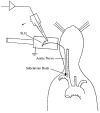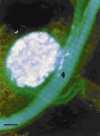Activity of aortic chemoreceptors in the anaesthetized rat
- PMID: 9882753
- PMCID: PMC2269104
- DOI: 10.1111/j.1469-7793.1999.821ad.x
Activity of aortic chemoreceptors in the anaesthetized rat
Abstract
1. It has been widely accepted that the rat aortic depressor nerve contains only baroreceptors. However, the experiments which have provided these negative data have employed whole aortic nerve recording. In the present study, the technical difficulties associated with recording single fibres in vivo, from the rat aortic nerve (diameter 25-50 microm), have been surmounted using a small tip, glass suction electrode technique. 2. Upon switching from normocapnic hyperoxia to hypercapnic hypoxia, irregularly firing units (n = 13) appeared and these were significantly excited by intravenous injections of sodium cyanide (20 microg) but not by rises in arterial blood pressure induced by methoxamine (an alpha1-adrenoreceptor agonist; 10 microg). Inhalation of 100 % oxygen rapidly and reversibly silenced, or profoundly reduced, ongoing activity. 3. Intravenous injection of phenylbiguanide (PBG; a 5-HT3 receptor agonist; 8 microg) strongly stimulated the chemoreceptors and was followed by a period of chemodepression (3-21 s). In contrast none of the single fibre baroreceptors recorded (n = 15) were excited by PBG but all significantly increased their discharge in response to the increases in arterial blood pressure associated with methoxamine and cyanide. Both the excitatory and inhibitory effects of PBG on the chemoreceptor fibres were abolished by ondansetron (a 5-HT3 receptor antagonist: 1 mg kg-1 i.v.; n = 5 animals) whilst the chemoexcitatory action of cyanide was preserved. 4. It is concluded that there are chemoreceptor afferents contained in the aortic nerve of the Sprague-Dawley rat. The 5-HT3 receptor appears not to be a pre-requisite for aortic body chemoexcitation.
Figures







References
-
- Cheng Z, Powley TL, Schwaber JS, Doyle FJ., III A laser confocal microscopic study of vagal afferent innervation of rat aortic arch: chemoreceptors as well as baroreceptors. Journal of the Autonomic Nervous System. 1997;67:1–14. - PubMed
-
- Coleridge HM, Coleridge JCG, Howe A. Thoracic chemoreceptors in the dog: a histological and electrophysiological study of the location, innervation and blood supply of the aortic bodies. Circulation Research. 1970;26:235–247. - PubMed
-
- Daly MdeB. Peripheral Arterial Chemoreceptors and Respiratory-Cardiovascular Integration. London: Monograph of the Physiological Society No. 46, Clarendon Press; 1997.
Publication types
MeSH terms
Substances
Grants and funding
LinkOut - more resources
Full Text Sources

